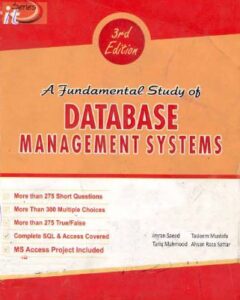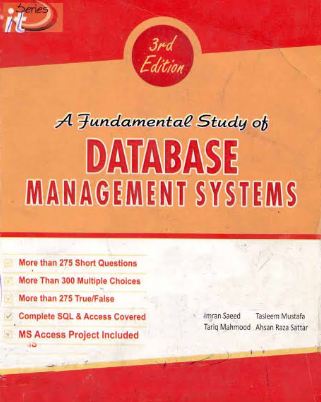Database Management Systems by Tasleem Mustafa & Imraan Saeed ( 3rd Eddition )
A database management system (DBMS) is computer software for making and managing complex databases. The most common form of database management system, the DBMS basically serves as an interface between computers and users or applications, ensuring that important data is well organized and stays easily accessible. It also plays a key role in efficiently handling the organization’s financial transactions. However, choosing a good DBMS requires a lot of attention, because it not only enhances the productivity of your business but also represents the most important part of your IT infrastructure.

There are two major components that make up a good database management system, which are the operational data management and a quality management system. The former aims to ensure that all changes made to the database are deployed according to the original set of rules, and the latter focuses on data integrity. Both of these systems must work hand in hand to ensure the well-being of both the company and its end users. Thus, you need to have the best DMS solution available in order to minimize security risks and improve data integrity.
Most enterprise SQL servers are designed with two-tier architecture in view of the fact that they can be effectively combined with a wide variety of database management systems. The two-tier architecture ensures that the SQL server and the application server do not end up having conflicting rules, as well as a clear view of how changes to the database schema occur. In fact, there is no way an unauthorized user could access information in the database unless the two tiers are properly combined. This way, end users do not need to be aware of how the two tiers work together and achieve data integrity.
Modern Digital And Analog Communication System 4th Edition
When it comes to designing a good Database Management System, there are two main concerns to take note of. First, end users should be able to gain access to all the data in the database no matter who owns the database. Second, an end user cannot affect or change the existing rules of the database management system. This means that if there are modifications to the database schemas, users cannot simply make any changes to their entities.
Some companies make the mistake of believing that a successful DMS requires comprehensive reporting capabilities. True, comprehensive reporting will allow end users to trace, and trace data that moves around the system. However, such detailed data integrity monitoring is only part of the overall picture of securing the data.
Database management systems must also maintain integrity at all times. This includes random access, table and column level security, transaction log integrity, and application and stored procedures as security. Without these aspects of a well-maintained system, database corruption becomes a serious threat. Database corruption can result from any number of reasons, including improper permissions, corrupt schemas, badly written code, server crash, human error, and so on. Whatever the cause, once a database file becomes corrupt, it can take a very long time to recover data.
It is critical for the end user to understand the database security features of a company’s DMS. This will include all aspects of database administration including recovery, reporting, and restoration. Database security is an intricate and vital aspect of any enterprise DMS and must be taken care of by a company with extensive experience in database management. Any company that does not have the appropriate experience in database security is likely to make errors in the design and implementation of its system.
No system can provide the level of service that a well-designed DMS can. A good DMS is able to provide the end user with accurate, timely reporting of all database transactions, and allow the system administrator to create policies for enforcing different rules for different user groups. A good system should also allow for off-site or remote back up, should allow for the creation and modification of database policies and allow for the transfer of data to other machines. Database management systems are therefore more than just simple systems designed to manage databases!





